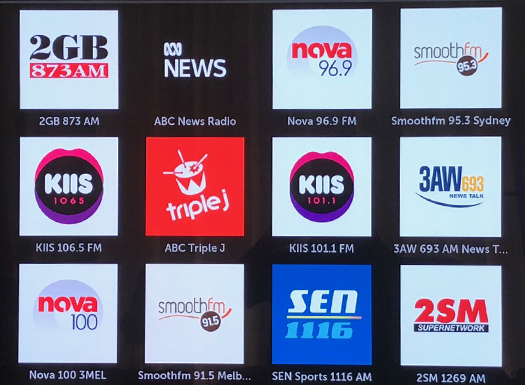There was an interesting thread on twitter in the past week about callsigns.
It all started with a post from Anthony Bunn who asked, “how did the requirement to use callsigns on-air operate?”
James Cridland replied saying, “There’s no requirement for radio stations to use their callsigns on air any more, incidentally. Nobody knows Nova is 4BNE, and ABC Radio Brisbane hasn’t used theirs for over 5 years. They’re a bit anachronistic but useful for smart speakers, oddly (since they’re unique).”
Brett Debritz chipped in with, “From (perhaps flawed) memory, back when Triple M was FM104, they’d say something like “This is 4MMM Brisbane operating on 104.5MHz as FM104”. I know that in the old ham (amateur) radio days, signal identification and post cards to acknowledge reception were a big thing.”
This week in the Mister Brisbane newsletter: A bit about Brisbane's history, something about radio, and a bit more about scones and postcodes …https://t.co/jez5PG1x10
— Brett Debritz (@debritz) February 16, 2021
…there's no requirement for radio stations to use their callsigns on air any more, incidentally. Nobody knows Nova is 4BNE, and ABC Radio Brisbane hasn't used theirs for over 5 years. They're a bit anachronistic but useful for smart speakers, oddly (since they're unique).
— James Cridland (@JamesCridland) February 16, 2021
James Cridland then tagged radioinfo’s, Steve Ahern who added, “What an interesting discussion. Thanks for looping me in James.
“This is what I know: Yes, identifying callsigns and frequency was mandatory at station open and close (in the days when stations went off at night). It was a requirement from the early days of radio licencing from when the Post Master General (PMG) controlled licences.
“This passed to the ABT (Aust Broadcasting Tribunal) and was in a broadcasting handbook, but evolved to mandatory identification every hour. There was no requirement to identify individual repeater frequencies.
“All such on air identification requirements were dropped as callsigns evolved when FM was introduced in the late 1970s with 3 letter callsigns and brand names rather than licence identifiers.
“By then the ABT had become the ABA (Aust Broadcasting Authority), then the ACMA and a ‘light touch co-regulatory’ regime (cheaper for governments) was introduced. Bureaucrats sitting in regional offices all around the country no longer had to monitor stations to listen for mistakes (don’t get me started on mandatory weather and timecalls!)
In Australia the official callsigns begin with numbers that represent each state. In America it is different, they use letters and divide locations by west or east of the Mississippi River.
In America callsigns are issued by then Federal Communications Commisssion (FCC) and consist of from 3 to 9 letters and digits, with their composition determined by a station’s service category. By international agreement, all call signs starting with the letters K, N and W, as well as AAA–ALZ, are reserved exclusively for use in the United States.
AM, FM, TV and shortwave broadcasting stations can request their own call letters, as long as they are unique. The FCC policy covering broadcasting stations limits them to call signs that start with a “K” or a “W”, with “K” call signs generally reserved for stations west of the Mississippi River, and “W” limited to stations east of the river. Amateur stations can receive call signs starting with all of the letters “A”, “K”, “N” and “W”. Formerly, prefixes beginning with “A” were exclusively assigned to U.S. Army stations and prefixes beginning with “N” to U.S. Navy stations. More here.
James Cridland then went to work to look at the history of callsigns in the UK
The history of callsigns in the UK is short and sweet. Here we go…
The first BBC broadcast on 14 November 1922 was under the callsign of 2LO. 2LO was the transmitter in The Strand in London, acquired by the British Broadcasting Company from Marconi. The first thing on the BBC was a news bulletin: read by Director of Programming Arthur Burrows twice: once fast, then slowly, so listeners could take notes.
(If the “LO” callsign sounds familiar, it’s because 3LO in Melbourne, which started broadcasting in 1924, was named after London’s 2LO. It’s now known as ABC Radio Melbourne.)
By the end of 1922, the BBC had four transmitters: 5IT in Birmingham, 2ZY in Manchester, and 5NO in Newcastle. 1923 saw 5WA in Cardiff, 5SC in Glasgow, 2BD in Aberdeen, 6BM in Bournemouth. All these stations provided local programming because there was no way of linking them to broadcast a network service; but by mid 1923, the first national BBC news bulletin was broadcast, and the first relay service launched, 6FL in Sheffield (which rebroadcast 2ZY from Manchester).
All callsigns were removed on March 9 1930: the transmitters broadcasting either the “BBC Regional Programme” or the “BBC National Programme”. The Regional Programme was quite similar to today’s ABC Radio, with a mix of local programming and a sustaining service from London. At the outbreak of World War II, the two stations were replaced with one – the BBC Home Service, now known as BBC Radio 4. Callsigns have never been used since.
When UK commercial radio started in October 1973, no callsigns were used. Instead, the commercial radio regulator, the IBA (the Independent Broadcasting Authority) had a very hands-on approach: any changes of the name of a radio station, and even its daily broadcast schedule, needed to be approved in advance by the Authority. So, while UK commercial broadcasting has never had callsigns on-air, in many ways it does: the legal callsign is the name of the radio station, and the rules remain that it should be regularly identified as such, and any changes of name be approved by the regulator, which these days is known as Ofcom.
With RDS and DAB broadcasting (and the AM version, called AMSS), we return full-circle: a radio station now carries constant identification.
Subscribe to the radioinfo podcast on these platforms: Acast, Apple iTunes Podcasts, Podtail, Spotify, Google Podcasts, TuneIn, or wherever you get your podcasts.





If anyone wants to know the official callsign registered at the ACMA, there is an Excel spreadsheet containing the transmitter's registered call sign.
Here are some examples of radio stations who don't use the transmitter's registered call sign:
Melbourne - examples
ABC774, registered as 3LO
SEN 927, registered as 3UZ
SEN 1116,registered as 3AK
Magic1278, registered as 3EE
Sydney - examples
RN, 2RN formerly registered as 2FC
ABC702, registered as 2BL
SkySportsRadio, registered as 2KY
SEN1170, registered as 2CH
Smooth, registered as 2PTV
Nova, registered as 2SYD
WSFM, registered as 2UUS
Hope103.2, registered as 2CBA
KIIS106.5 (formerly MIX106.5, formerly 2UW), registered as 2WFM
Source: https://www.acma.gov.au/sites/default/files/2021-02/BroadcastTransmitterAccess.zip
Thank you,
Anthony of researching Belfield
Callsigns are a unique identifier for each broadcasting licence. They are used for identifying individual broadcasting licences in the regulatory system where many individual broadcasting licences may share a common on air brand name.
There is no requirement for stations to mention their call signs on air anymore, ACMA is usually smart enough to work out which individual licence a complainant is talking about.
Dear Mr St John,
Two points:
(1) I agree with you that the spreadsheet should show more information such as network and locality. "Brand" names rather than call sign don't give an indication of the locality of the branded station. For example MMM, Mix and Hit.
(2) Where you said "...The ABC no longer calls their capital city stations by ABC and frequency, instead they are called ABC and the region name..." On Sydney's 2BL, where the programs are for Sydney-only, the presenters say, "...this is ABC702..." BUT for RN, the presenters never mention the frequency, but say "...you're on RN and you're listening to program name..."
A hint of the source of the program material is when the presenter announces the SMS number for listeners' feedback. The last three digits of the SMS number represent the AM frequency. For example, A program sourced from Sydney's RN asks listeners to SMS -------576, Sydney's Metropolitan asks listeners to SMS ------702 while a program sourced from Melbourne's Metropolitan asks listeners to SMS ---------774.
A final remark, when it comes to DAB+ stations, I agree that frequency is irrelevant. For example on DAB+'s main display or scrolling text, 2GB identifies itself as 2GB 873 and WSFM identifies itself as KIIS 106.5, not Channel 9B on 204.640MHz with ID 0x11D0 and Channel 9B on 204.640MHz with ID 0x1181 respectively.
On the other hand the DAB+ versions of the AM or FM stations are easily recognised by their brand/callsign and frequency rather than its frequency and ID. You don't say, "This is 2GB broadcasting on 873kHz and on DAB+ on 204.640MHz with ID 0x11D0 in hexadecimal or 4560 decimal." There is still an association between the legacy AM or FM band with the DAB+.
Similarly, the commercial TV stations the DVB versions Seven, Nine and Ten are referred by its legacy VHF frequency bands, 7, 9 and 10 and their respective logical channel numbers. Press 7 or 9 or 10 on the remote and you'll get their SD channel.
Thus the DVB frequencies for Seven, Nine and Ten are on VHF channels 6, 8, and 11 respectively. IT is the particular network's logical channel number that refers to its legacy VHF band.
SBS broadcasts on VHF channel 7, which was formerly the Seven Network's band when it was broadcasting in analogue. SBS's main program has a logical channel number 30 which is not based on its former UHF channel 28.
Thank you,
Anthony of exciting Belfield
https://www.acma.gov.au/list-transmitters-licence-broadcast contains a link to an Excel spreadsheet. The link above is for a database which requires a database program to read. Such a program is not present on the cheapest version of office.
There is generally 3 AM transmitters often from different broadcasters per frequency across Australia and in the FM band there are many more transmitters per channel.
In radio now there is lots of networking as well as translators/repeaters. A call sign should reflect a unique program source. For example ABC local radio has 58 regional studios, which transmitter is connected to which studio. This is particularly important in the country during emergencies where some studios are staffed continuously during an emergency only. If you listen to the wrong transmitter you could miss out on vital information.
Instead of the spreadsheet showing commercial or national, it should replace this with the network name eg. ABC Region name or commercial broadcaster network name eg. Southern Cross/Ausstereo
With the advent of smart speakers the advantage of call signs make each studio name unique. Since the internet is world wide, and particularly Australia wide, most want the local studio of a network. For example how many broadcasters worldwide call their stations "Hits"!
Anthony, The ABC no longer calls their capital city stations by ABC and frequency, instead they are called ABC and the region name.
Many stations use the their frequency as identification, however with digital radio this is irrelevant. All Australian broadcasts are between 195 - 209 MHz and there are up to around 20 programs per channel.
They should either use a call sign or a name which does not include a frequency including simulcasts with AM/FM. For those who do not have a digital radio, the radio scans the channels and produces an alphabetical list of programs. No mention of frequency unless you go to the info screen.
Lastly using names can be a problem such as MIX which in all capital cities except Perth it is owned by ARN but the Perth station (6MIX) is owned by Southern Cross/Austereo and its on air name has always been "MIX 94.5"
DAB+ station identifiers probably include frequencies because most people listen to a station across a range of platforms. AM and FM radio is likely still the most common so it's worthwhile to continue to associate the primary analog frequency with the station name.
Callsigns are assigned to broadcast licences, not transmitters. A broadcast licence may have several transmitters associated with it to provide coverage across the licenced area. Individual transmitters are licenced under apparatus licences, and the apparatus licences for each individual transmitter are associated with the broadcasting licence identified with a traditional call sign.
Anthony,
The ABC does lots of networking which is one of the reasons why they no longer use frequencies. Programs can come from anywhere on the network.
In addition you use the example of ABC Sydney has a translator in Gosford on 92.5 FM. https://www.abc.net.au/radio/centralcoast/ which is very low power. With the exception of Breakfast the program is purely ABC Sydney. There is of course ABC Illawarra which is on the high powered 97.3 FM.
Prior to FM, AM stations had to use their call signs. When FM started the call signs became longer by a letter and the requirement was dropped. So listeners could find the station on the dial, broadcasters started using frequencies as an identification. This becomes a problem because as coverage areas get bigger the need for translators increases and these must be on another frequency to prevent interference.
As with the new stand alone digital stations, the list should not include the frequencies as they are wrong. We have been transmitting DAB+ since 2009 and we are still without a plan to switch off the inefficient AM and FM transmitters in capital cities.